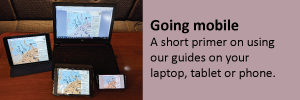Eastsound feels bigger than it is

Framed by Indian Island on the right and the county dock on the left, a triamaran has a view south down Orcas Island’s East Sound. (Photo by CAD Graphics Inc.)
The little community is one of the few surprises that awaits summertime visitors.
Boaters can anchor south of the inner bay, off Indian Island and outside an area marked by a sign on the shore where dropping an anchor is prohibited to protect threatened eel grass. A few private mooring buoys inside the zone are excepted. It is okay to tie up at the county dock inside the protected zone, but overnighting here is not allowed.

Aerial view north over the village of Eastsound and north from Orcas Island to Sucia Island and other Boundary Islands near the Canadian border. (Photo by C. Duenas)
Indian Island, a little over an acre in size, was once named Jap Island. That was its official name, earned because a Japanese man lived alone there in a small cabin. Times changed, and the island was named for a different race.
Today, Indian Island is a marine health observatory under the auspices of the Center for Historical Ecology of the Salish Sea (Kwiáht), a non-profit which works with locals to protect the marine environment.

Chartlet from Salish Sea Pilot’s Cruising Guide to the San Juan Islands. Not to be used for navigation.
The island and the bay crawls and swims with all manner of strange critters, from grunt sculpins to decorator crabs. At low low tide, a sand tombolo connects the island to a small public park ashore.
The float at the county dock on Madrona Point typically has lots of room for dinghies to tie up. The float is removed in the off-season, so dinghies must go ashore on the beach just north of the county dock or up the park beach north of Indian Island.
Ashore, south from the pier, was an ancient burial site of the Lummi Tribe, and public access to the point has been blocked in a dispute about camping and partying on the sacred land.

The tombolo that reaches ashore from Indian Island begins to form as the tide falls in Fishing Bay. (Photo by Matt Marshall)
Turn north to take the road into town, where on a warm summer day a metropolis awaits. Eastsound feels big, the sidewalks and shops teeming with tourists and locals, happy faces and children struggling with ice cream cones. Provisioning is good, with a supermarket, pharmacy and hardware store. There are restaurants, galleries, a museum, even a Saturday farmers’ market. It is easy to spend the better part of a day here.
Fishing Bay offers no protection from the south. In unsettled conditions, the best shelter is found less than a mile to the southwest in Judd Bay, where there is dinghy access ashore from where it is a walkable distance to town.
The marvelous hiking opportunities within Moran State Park are best accessed from Cascade Bay, three nautical miles south.
(Eastsound is covered in Salish Sea Pilot’s Cruising Guide to the San Juan Islands.)


















